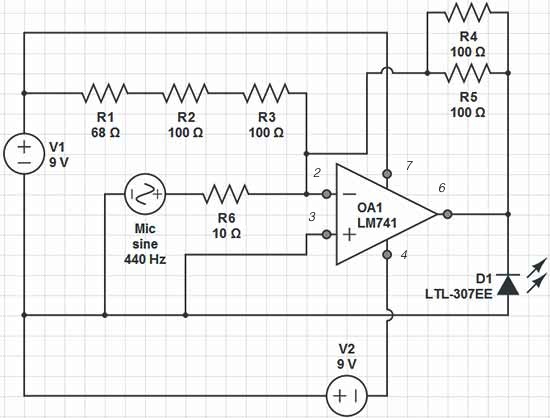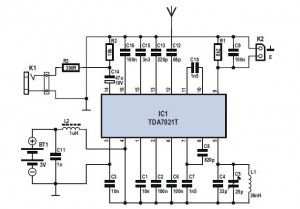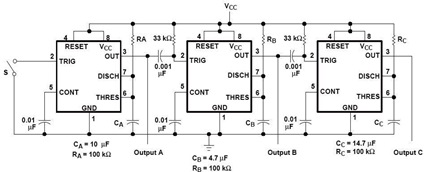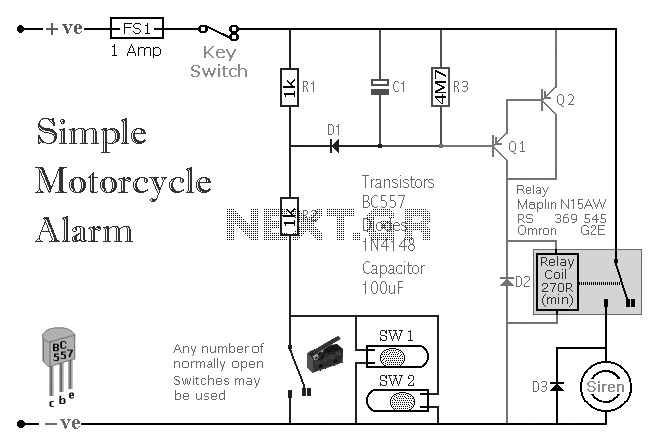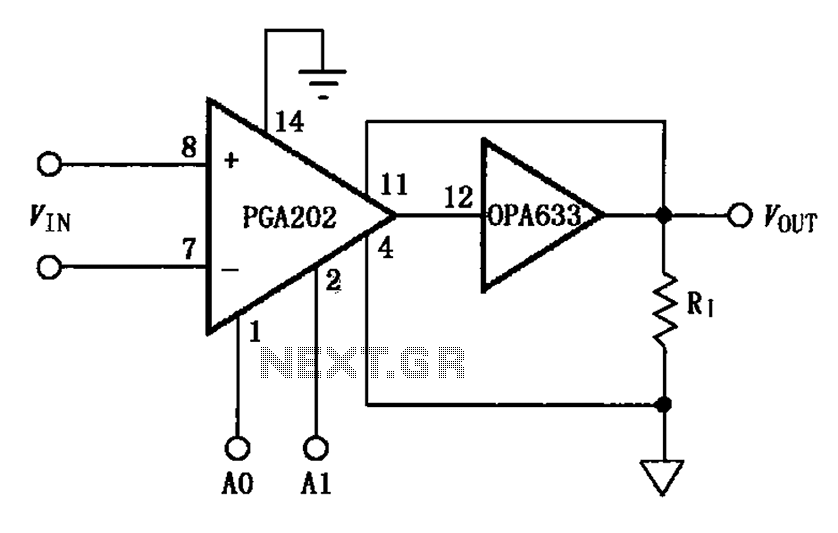
a simple Astable Multivibrator with the help of a circuit diagram
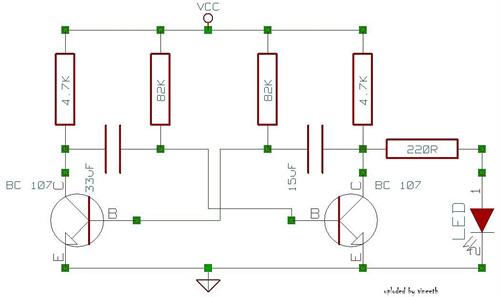
An astable multivibrator is a switching circuit that alternates its output on and off for a designated time period. This device, also known as a free-running oscillator circuit, is primarily utilized to generate square waves over a specified duration. The term "astable multivibrator" is applied because it lacks a stable state, continuously oscillating between two quasi-stable states. When the DC supply is initially activated, even though both transistors are made from the same material, there may be slight discrepancies between them, which is essential for generating oscillations. This effect is further amplified by the transistor configuration depicted in the accompanying diagram. The collector terminal of transistor T1 is linked to the base of transistor T2 through capacitor C1, while the collector terminal of T2 is connected to the base of transistor T1. This configuration ensures that only one transistor can remain in the on state at any given time. The time period of oscillation is determined by the capacitors connected to the bases of the transistors. At the moment the supply is applied to the circuit, any imbalance among the transistors may cause one transistor, such as T1, to conduct more than the other. When T1 turns on, its collector potential reaches VCEsat, approximately 0.3V, which results in transistor T2 receiving a base potential lower than the cutoff voltage of 0.7V, preventing it from turning on. As the capacitor C1 is connected in series with the base terminal of T2, it charges to Vcc through the resistor RC1. As C1 charges, the base voltage of T1 increases exponentially, and once it exceeds 0.7V, T2 turns on. However, the collector voltage of T2 drops to VCEsat, which is also connected to the base of T1, driving T1 into the off state. Consequently, capacitor C2 charges to Vcc through resistor RC2, and when the base voltage of T1 exceeds 0.7V, T1 turns on, causing T2 to turn off. This regenerative process continues as long as the power supply remains active. The oscillation period is influenced by the values of capacitors C1 and C2. While the circuit can be designed to function as intended, small variations may occur due to the tolerances of the capacitors and resistors, as only standard-value components available in the market were utilized.
The astable multivibrator circuit typically consists of two NPN transistors, two resistors (R1 and R2), and two capacitors (C1 and C2). The configuration allows for continuous switching between the two transistors, creating a square wave output. The resistors R1 and R2 are connected to the collector terminals of the transistors, providing biasing and stability to the circuit. The capacitors C1 and C2 are crucial in determining the frequency of oscillation, as they charge and discharge, controlling the timing of the switching action.
In practical applications, the frequency of oscillation can be calculated using the formula:
\[ f = \frac{1.44}{(R1 + R2) \cdot (C1 + C2)} \]
Where:
- \( f \) is the frequency of the output square wave,
- \( R1 \) and \( R2 \) are the resistances in ohms,
- \( C1 \) and \( C2 \) are the capacitances in farads.
Additionally, the duty cycle of the output waveform can be adjusted by varying the values of the resistors and capacitors, allowing for flexibility in design based on specific application requirements. The astable multivibrator is widely used in applications such as clock pulses, tone generation, and timer circuits due to its simplicity and effectiveness in generating a square wave output.An Astable Multivibrator is a switching circuit which switches its output on and off for a designed time period. This article also describes about its working. An Astable Multivibrator or a free running oscillator circuit is generally used to generate square waves for a specified time period.
The name Astable Multivibrator is used for it because, it does not have a stable state and it switches between two quasi stable states. Consider the instant at which the DC supply is switched on. Even though, both the transistors are made of the same material their is a chance for disproportion among the two and That is the key to the generation of vibrations. This phenomenon is further enhanced by the transistor configuration as shown in the figure. The collector terminal of T1 is connected to the base of T2 via a capacitor C1 and similarly the collector terminal of T2 is connected to the base of transistor T1.
So, due to this configuration only one transistor can remain switched-on at a time. The time period is determined by the capacitor connected to its base. As said above, at the time of providing supply to this circuit, any imbalance among the transistors can cause any one of the transistor to conduct more, let it be T1 now. As T1 turns on its collector potential will be VCEsat which is approximately equal to 0. 3v therefore the transistor T2 will get a base potential less than the cutin voltage 0. 7 and this prevents transistor T2 from turning on. Now since the capacitor C1 is connected in series with the base terminal of T2, the capacitor charges to vcc through RC1 resistor.
As the capacitor charges, the base voltage of T1 increases exponentially and when it is more than 0. 7 v, the T2 turns on. But the collector voltage of T2 drops to VCEsat which in turn is connected to the base of T1 and it drives T1 to switched-off state. Now C2 charges to vcc through Rc2 resistor and when the base voltage of T1 is more than 0. 7v T1 turns on and T2 goes off. This regenerative action continues until the power supply is maintained. Thus the time period depends on the value of C1 and C2 This circuit can function as as per our design.
But, there may be some small variation subsequently, because of the approximation provided in the values of capacitor and resistors. in fact we used only standard valued components available in market. 🔗 External reference
The astable multivibrator circuit typically consists of two NPN transistors, two resistors (R1 and R2), and two capacitors (C1 and C2). The configuration allows for continuous switching between the two transistors, creating a square wave output. The resistors R1 and R2 are connected to the collector terminals of the transistors, providing biasing and stability to the circuit. The capacitors C1 and C2 are crucial in determining the frequency of oscillation, as they charge and discharge, controlling the timing of the switching action.
In practical applications, the frequency of oscillation can be calculated using the formula:
\[ f = \frac{1.44}{(R1 + R2) \cdot (C1 + C2)} \]
Where:
- \( f \) is the frequency of the output square wave,
- \( R1 \) and \( R2 \) are the resistances in ohms,
- \( C1 \) and \( C2 \) are the capacitances in farads.
Additionally, the duty cycle of the output waveform can be adjusted by varying the values of the resistors and capacitors, allowing for flexibility in design based on specific application requirements. The astable multivibrator is widely used in applications such as clock pulses, tone generation, and timer circuits due to its simplicity and effectiveness in generating a square wave output.An Astable Multivibrator is a switching circuit which switches its output on and off for a designed time period. This article also describes about its working. An Astable Multivibrator or a free running oscillator circuit is generally used to generate square waves for a specified time period.
The name Astable Multivibrator is used for it because, it does not have a stable state and it switches between two quasi stable states. Consider the instant at which the DC supply is switched on. Even though, both the transistors are made of the same material their is a chance for disproportion among the two and That is the key to the generation of vibrations. This phenomenon is further enhanced by the transistor configuration as shown in the figure. The collector terminal of T1 is connected to the base of T2 via a capacitor C1 and similarly the collector terminal of T2 is connected to the base of transistor T1.
So, due to this configuration only one transistor can remain switched-on at a time. The time period is determined by the capacitor connected to its base. As said above, at the time of providing supply to this circuit, any imbalance among the transistors can cause any one of the transistor to conduct more, let it be T1 now. As T1 turns on its collector potential will be VCEsat which is approximately equal to 0. 3v therefore the transistor T2 will get a base potential less than the cutin voltage 0. 7 and this prevents transistor T2 from turning on. Now since the capacitor C1 is connected in series with the base terminal of T2, the capacitor charges to vcc through RC1 resistor.
As the capacitor charges, the base voltage of T1 increases exponentially and when it is more than 0. 7 v, the T2 turns on. But the collector voltage of T2 drops to VCEsat which in turn is connected to the base of T1 and it drives T1 to switched-off state. Now C2 charges to vcc through Rc2 resistor and when the base voltage of T1 is more than 0. 7v T1 turns on and T2 goes off. This regenerative action continues until the power supply is maintained. Thus the time period depends on the value of C1 and C2 This circuit can function as as per our design.
But, there may be some small variation subsequently, because of the approximation provided in the values of capacitor and resistors. in fact we used only standard valued components available in market. 🔗 External reference
Warning: include(partials/cookie-banner.php): Failed to open stream: Permission denied in /var/www/html/nextgr/view-circuit.php on line 713
Warning: include(): Failed opening 'partials/cookie-banner.php' for inclusion (include_path='.:/usr/share/php') in /var/www/html/nextgr/view-circuit.php on line 713
